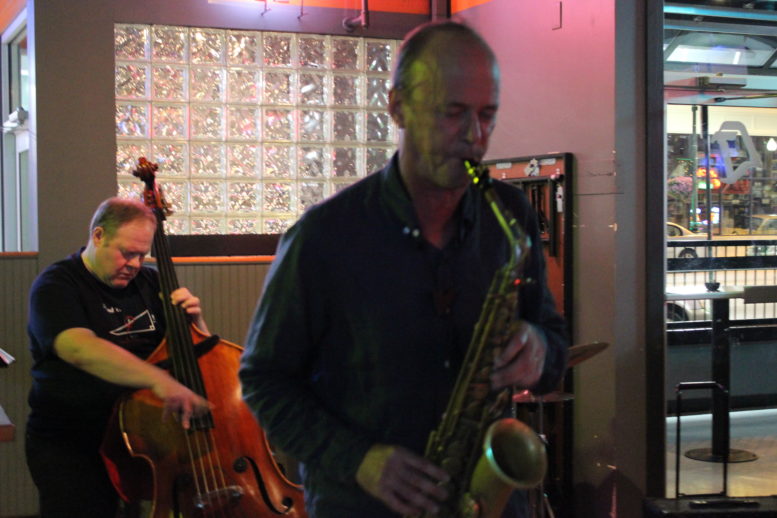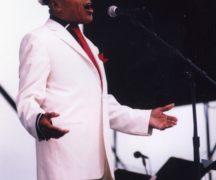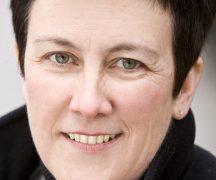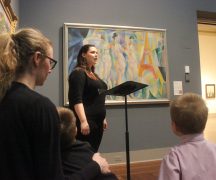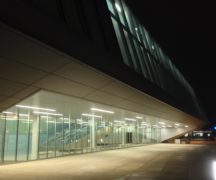By DAVID DUPONT
BG Independent News
Jazz lives in downtown Bowling Green. Even a tornado couldn’t keep the jazz sessions from getting started earlier this semester.
For most Wednesday nights over the last 35 years, jazz jamming has been a staple on the Wednesday night scene. Sometimes it’s students, sometimes it’s the biggest names in the business. It just depends on the night.
“It’s taken on different shapes and colors over those 35 years,” said bassist Jeff Halsey.
What’s now called Jazz Studies Night has settled into Bar 149, at 149 N. Main St. starting at 8:30.
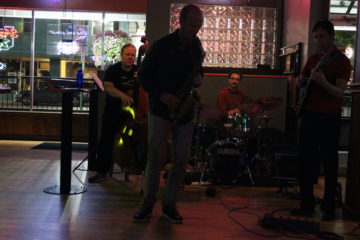 The sessions feature the Bowling Green State University jazz faculty quartet of Halsey, David Bixler, alto saxophone, and Ariel Kasler, guitar, and newcomer Dan Piccolo, drums, during the first hour or so. In the second set, student start filtering into the lineup, putting to the test the lessons learned on campus.
The sessions feature the Bowling Green State University jazz faculty quartet of Halsey, David Bixler, alto saxophone, and Ariel Kasler, guitar, and newcomer Dan Piccolo, drums, during the first hour or so. In the second set, student start filtering into the lineup, putting to the test the lessons learned on campus.
That on-the-bandstand experience is crucial to their development. “You really have to be here if you want to be a jazz player,” Halsey said. “This is part of the community hang.”
Visiting musicians to take part in the action.
When internationally known star Branford Marsalis did a residency on campus, he showed up to play a set with the faculty.
When guitarist Mike Stern’s concert with the Jazz Lab Band I was canceled in January, 2014, because of a snow storm, it was rescheduled for Jazz Night with the entire big band packed into a corner of the club.
And exactly a year later, after a long day of delayed flights, the then 88-year-old Jimmy Heath rolled into the bar round about midnight, pulled out his saxophone and wailed. Jazz history had come to call.
“Jazz is an art form that takes shape in a community,” Bixler said. Spending time in the practice room, using play-along recordings is part of learning, he said, “but you really learn how to play by playing.”
“On the bandstand everything is different. You learn how to communicate, how to start and end songs, how to keep a mistake from derailing the whole piece, how to react to the melodic, harmonic, and rhythmic input of your bandmates,” he wrote in an email.
What the students learn in the studios and practice rooms of the Moore Musical Arts Center blossoms in the dim light of the 149 stage. “This is honestly one of the best classes they have,” Bixler said.
The sessions started in Halsey’s first year on campus. Vic Pirooz, Easy Street owner, approached him about adding jazz to what was then six nights of music in the room above the restaurant. The place had a full stage and good sound system.
Halsey said at that time the sessions were turned over to students to run. Halsey said he’d occasionally drop by to sit in but “they were in charge of it.”
That continued for a number of years. Along the way, some students who went on to professional careers including bassist Mike Pope and drummer Mike Petrosino honed their chops at the sessions.
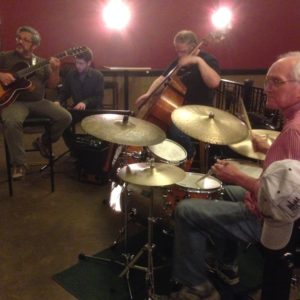
Roger Schupp on drums during one of his last Jazz Night performances.
When percussionist Roger Schupp joined the BGSU faculty in 1992, he took an interest in the sessions. He knew Pirooz and they worked out a new arrangement. The faculty took center stage.
“Roger was the impetus,” Halsey said.
It was during this time that the faculty jazz ensemble took shape. For a few years the quartet – Schupp, Halsey, guitarist Chris Buzzelli and pianist Russ Schmidt – was an official resident ensemble on campus.
The room – this was before it was called Grumpy Dave’s – was an off-campus hangout for the jazz program.
Buzzelli brought a number of guitarists to campus including Frank Vignola, Randy Johnston and Gene Bertoncini, and they played on Jazz Night. Visiting artists including Howard Johnson sat in. John Hollenbeck’s Claudia Quintet did a show back in 2002.
At that time the faculty took the money they earned playing the gig to create “a nice nest egg” to help bring these musicians to campus.
It became the place where the local jazz community came to hang out, Halsey said. “It was important to me to be out with the students in a different social environment.” And it could get “kind of rowdy.”
Over the years though the room put less emphasis on music, and more on having a place people could come and play games and pool.
The sessions were adrift for a bit. In 2005-2006 they found a temporary home across the street at the upstairs bar at what was then DiBenedetto’s. That was a small, packed space with food and drink prices not as conducive to a student budget.
“This needs to take place where college students feel comfortable hanging,” Halsey said.
Schupp located just the venue when he arranged for the sessions to settle into what was then 149 North.
All this happened without much promotion. This writer discovered the new venue when strolling downtown and spying Schupp setting up his kit on the other side of the bar’s window.
That’s where the sessions settled into its new home. Jazz Nights remained there, except for a period last year when they moved to the ClaZel. (Actually there were a couple nights at Doc Holliday’s next door before that.) It was at the ClaZel that the musicians said their farewells to Schupp who died in December from cancer. He was still playing Jazz Night a few weeks before his death.
Now with 149 under new ownership and with a new layout, the sessions have returned, and with them the regular crowd. Early in the evening are community residents and faculty members. As the night wears on, students come in, some carrying horn cases, others just to listen.
When Bixler arrived on campus in 2008 from New York City where he had an active career and as a sideman notably working with Lionel Hampton and Arturo O’Farrill, he took note of the tradition.
“I thought it was great that the faculty was getting out every week and playing,” he said. That they’ve maintained the tradition over so many years, adjusting to changing locations made it more impressive “given the general lack of support for jazz in this country.”
He continued: “Personally I welcomed the opportunity to play—jazz is a doing art form – you have to be creating it in the present tense in order to stay involved as an improvising musician.”
The sessions had something to offer him. Coming from New York, he’d been playing original compositions penned by himself and his peers. At Jazz Night the repertoire was standards, either from the American songbook or the jazz tradition.
“Playing the standards that the group was playing was a great discipline – a chance to revisit the music that I, and most jazz musicians, cut their teeth on,” Bixler wrote. “I will always have an affinity for that music and was excited for the chance to revisit it.”
This semester, a few original compositions will appear on the set list, Halsey said. Otherwise the songs are selected on the fly with the musicians occasionally asking those in attendance if there’s anything they want to hear.
With jazz almost an endangered species, sessions like those at 149 take on greater significance. “Jazz … needs a situation for musicians to do what they do,” Bixler said. The history of the music is full of the names of legendary clubs that offered that opportunity – the Village Vanguard, the Five Spot, and Minton’s Playhouse.
In its humble way, Bixler said, Jazz Night at 149 carries on that tradition.

